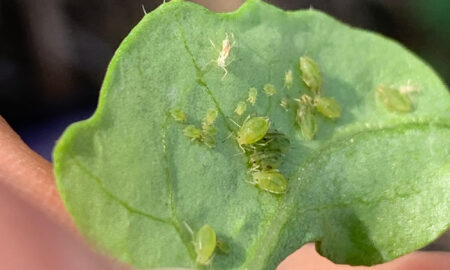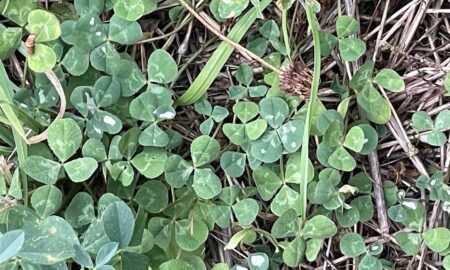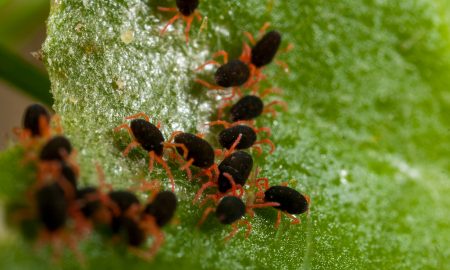The Grains Research and Development Corporation’s ‘Russian Wheat Aphid Regional Risk Assessment and Regional Thresholds’ investment has been running trial sites in 13 locations around South Australia, Tasmania, Victoria and New South Wales to determine regional pressure and economic thresholds for the aphid. These trial sites are closely monitored, with aphid counts conducted regularly.
We also have researchers hitting the highways during spring to undertake Russian wheat aphid surveillance as a part of our investigation into what factors make a summer green bridge a ‘high risk’ of harbouring the aphid in the lead up to planting.
Russian wheat aphid reports to Pest Facts services have been less common than over the 2018 winter cropping period. A reduction in reports could be for a variety of reasons.
It could indicate that the aphid has been less abundant during 2019, that our Pest Facts contributors are becoming more adept at identifying the aphid independently, or confidence in managing Russian wheat aphid is on the increase, leading to a reduction in reporting.
It could even be a case of all three factors at play.
We will soon have quantitative results from our targeted surveillance to further compare between 2018 and 2019 abundance, which will shed light on this question.
Without crunching all of the numbers, at this point we can say that project researchers on the road have made fewer detections of the aphid in South Australia, Victoria and New South Wales over the past few weeks compared to the same period in 2018, with most detections being of very small populations.
Only at a small number of sites have Russian wheat aphid numbers been high, with ‘hotspots’ of aphid activity displaying in excess of 150 aphids per tiller in multiple locations on cereal crops. However, these colonies were still quite localised.
This would indicate limited migration from the green bridge throughout the southern region compared to 2018. This is not unexpected – our surveillance indicated that Russian wheat aphid populations were at extremely low densities by April 2019, and the aphid distribution had substantially contracted after a dry summer. As a result, few aphids capable of migration from summer host vegetation during autumn may explain the patchy distribution and abundance that we are currently observing.
Migration of Russian wheat aphid – where is the next stop?
With warmer weather here, there is likely to be a build-up of Russian wheat aphid numbers, leading to populations becoming crowded and plant nutrients becoming less available. This will activate the development of winged Russian wheat aphid (alates), which will migrate during spring (cesar researchers have made detections of individual winged Russian wheat aphid over the past weeks, indicating that these aphids are migrating and have not yet settled down to begin new colonies).
At later stages of growth, cereal crops are unlikely to attract migratory aphids. In the unlikely event that infestation does occur at a mature growth stage (>GS 40), impact on yield is highly unlikely. Winged aphids are more likely to seek out actively growing alternate hosts, such as pasture species.
Our surveillance of the green bridge during late 2018-early 2019, as well as past work by the South Australian Research and Development Institute, indicated that key alternate host species include barley grass, prairie grass, great brome, soft brome, and volunteer cereals (regrowth from hay cuts and spilt grain volunteers).
While feeding symptoms in alternate hosts may be difficult to spot, we recommend monitoring for Russian wheat aphid throughout summer using the Berlese bag method, or take notice of feeding symptoms of volunteer barley or wheat. You can learn how to identify Russian wheat aphid in this Pest Bites episode:
In the meantime, until Russian wheat aphid migrate from your crop, keep an eye on your local beneficial populations, particularly parasitoid wasps, lacewings and ladybird beetle larvae and adults. We get the sense the ladybird beetles in particular have a real taste for this aphid!
An understanding of Russian wheat aphid ecology is an important part of making economically viable management decisions at the best time, and according to local risk. We are now in a better position to assess the risk of Russian wheat aphid leading into cropping – this risk is strongly related to local weather events and the availability of green hosts, particularly during late summer. The more data we have, the better future predictions will be.
If you see Russian wheat aphid symptoms and aphids please make a report. Send a photo with a date, place (GPS location) and host plant (if known) to the contacts below. These observations will be added to the distribution map on the Russian wheat aphid portal.
Acknowledgements
This research initiative is a GRDC investment that seeks to deliver information on Russian wheat aphid management for grain growers. This project is being undertaken by the South Australian Research and Development Institute (SARDI) and cesar.
Cover image: A Russian wheat aphid adult. Note the lack of apparent siphunculi and short antennae. Photo by Elia Pirtle, Cesar Australia





